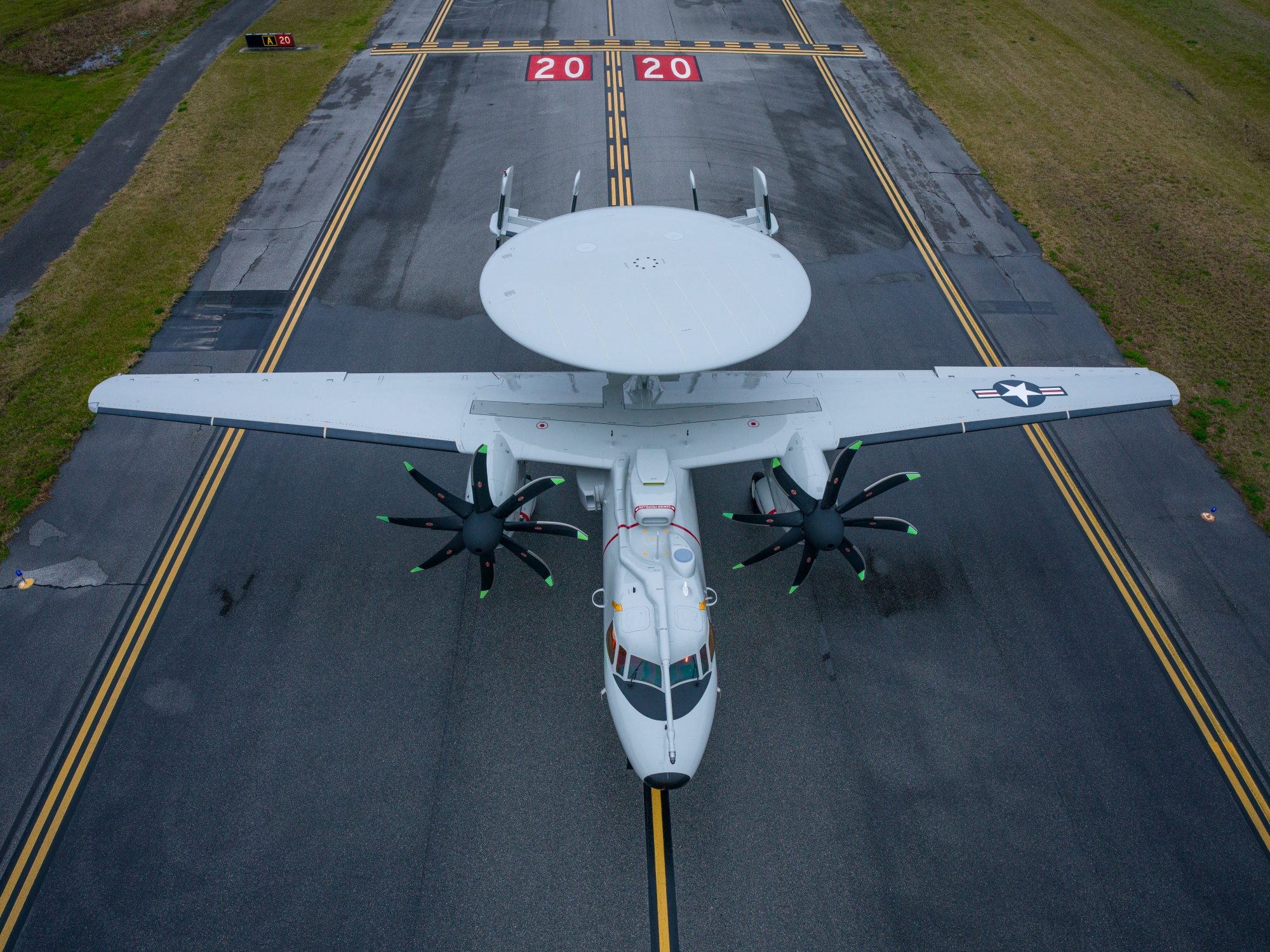Identified as one of the U.S. Navy’s top five acquisition programs, Northrop Grumman’s E-2D Advanced Hawkeye continuously outpaces evolving threats through modernization, delivering readiness for today and persistent capability for the future.
Based on a platform that has delivered six decades of airborne command and control, this aircraft is equipped to provide a 360-degree surveillance picture of all targets in its area of regard over water or land.
Here is what you need to know about Northrop Grumman’s E-2D Advanced Hawkeye and its modernization efforts.

Northrop Grumman’s E-2D Advanced Hawkeye continuously outpaces evolving threats. (Photo Credit: Northrop Grumman)
- Delivering Capability and Capacity. E-2D is operational in eight of the nine deployable U.S. Navy squadrons, with an active production line and an exemplary record of on-time delivery history. E-2D aircraft move directly from the production line to the fleet, ready for deployment across the globe. Advanced Hawkeyes operate globally throughout the United States and Japan. France, Egypt and Taiwan operate E-2C fleets. In 2027, France will transition to E-2D, and the U.S. Navy will transition its last E-2C squadron.
- Open Architecture. Built on open architecture, the Hawkeye boasts technology that reaches well into the future. Block II will improve connectivity for command and control and create a modular, open systems environment for future technology insertion, such as artificial intelligence and machine learning.
- Digital Development. Northrop Grumman is leading the strategic shift to model-based systems engineering and is converting legacy efforts to modern digital environments. E-2D’s next-generation mission computers and displays are being designed to support open mission systems architecture, which will allow for flexible and rapid future incorporation of containerized capabilities.
- AI and ML Transformation. The E-2D’s mission systems are designed to keep pace with future technology evolution like advancements in artificial intelligence and machine learning.
- Comprehensive Coverage. Equipped with an AN/APY-9 radar, E-2D delivers a real-time, precise common operating picture to the Joint Force. The APY-9 radar system provides a significant leap in capability for battle management command and control. This advanced radar system is designed to provide comprehensive coverage, leveraging the all-weather UHF band to provide unparalleled wide area surveillance in the most challenging environments. Its cutting-edge technology enables simultaneous air and surface tracking across all radar modes, setting a new standard for situational awareness in military operations over land and at sea.
- Continuous Modernization. Over the past decade, five major upgrades have been implemented in the E-2D, improving multiple systems, including APY-9 radar and satellite communications, and the addition of aerial refueling capability. Improvements were also made to data fusion along with upgrades to the sensors and counter electronic attack capability. The next iteration of the E-2D will be Block II, which will deliver capability, readiness and reliability upgrades paired with architecture improvements.
- Future Relevance. The Block II variant of the E-2D will provide avionics architecture improvements to flight and mission systems. This will improve the E-2D’s capabilities through human-machine interface enhancements, reducing pilot workload, and improving situational awareness. Block II capabilities will bring readiness and reliability upgrades in addition to architecture and cybersecurity improvements. Block II enhancements will increase crew effectiveness, computing capacity and electronic storage.
- Rapid Evolution. In just two and a half years from development to deployment, an upgrade was tested and fielded in 2023, with the first inline modification to production aircraft delivered to the Navy in December of that year. This upgrade improved the E-2D’s command and control capability, beyond-line-of-sight communications, sensor integration, and incorporated tactical targeting networking technology.
- Capabilities Beyond the Carrier. While primarily designed for airborne command and control, the E-2D can support a variety of missions including defensive and offensive counter-air, integrated air and missile defense, electronic warfare, air traffic control, combat search and rescue, humanitarian relief, border security and counter-drug operations.
- Next Generation Sustainment. Next generation maintenance and sustainment are delivered with applications that enhance diagnostics and reduce costs. Predictive maintenance technology improves E-2D readiness. While field service representatives deliver expertise through remote assistance or on the flight line, advanced E-2D analytic tools are employed to generate asset condition insights and recommendations.
With nearly 100,000 employees and over 30 million square feet of manufacturing space – more than 500 football fields – Northrop Grumman has the capacity, scale, and agility to drive innovation at unprecedented speeds. The company’s manufacturing approaches do more than just produce; they accelerate and enhance the entire process from design and development to production and testing. Northrop Grumman has invested in U.S. infrastructure, R&D, its workforce, and its supply chain to deliver today and tomorrow’s national security needs.
